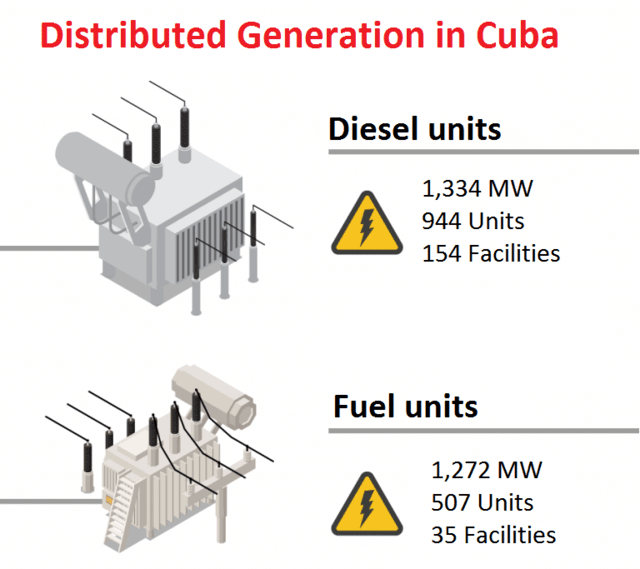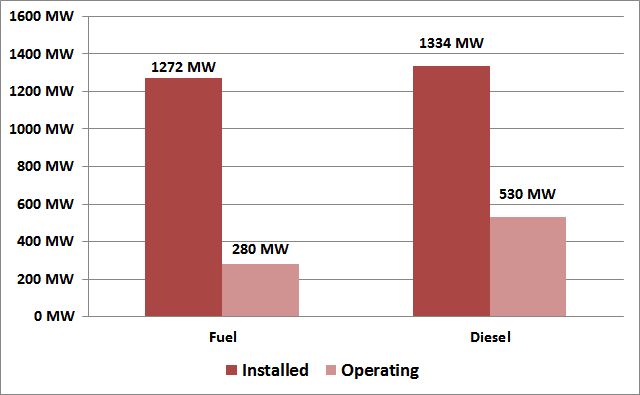Distributed Generation in Cuba: Present and Future
Distributed generation stands out in the Cuban power system, where there are hundreds of units dispersed throughout the country. In times of contingency, and as usually happens when a hurricane hits the country, distributed generation ensures the vitality of electrical service through interconnected systems in the form of “islands.”
Of the slightly more than 6,000 MW of presently installed power generation capacity in Cuba, 21.7% is supplied by fuel oil engines and 21.9% comes from diesel engines. Both technologies comprise many of the distributed generation facilities located across the country’s provinces.
The Beginnings
As explained by Arles Luna Leiva, director of Distributed Generation of the state-owned Unión Nacional Eléctrica (UNE), this generation source began as a program considered as part of the energetic revolution that took place between 2005 and 2009. It was conceived in two stages.
The first stage involved installation of the diesel equipment, which is comprised of 944 units installed throughout the country at 154 facilities with a total capacity of 1,334 MW. The diesel units are intended to cover the maximum demand or consumption peak, eliminate blackouts, serve as a backup in the event of contingencies in the electrical system, and provide service during “meteorological phenomena,” Luna Leiva said.
He explained that the second stage included the erection of 1,272 MW (507 units) of fuel oil equipment in 35 facilities (Figure 1), which were part of the base generation. These units make it possible to reach the necessary reserve for the operation of the Cuban electric power system (EPS), perform maintenance of power plants, and reduce diesel consumption.

Current Status
To sustain these groups, a planned preventive maintenance system was established. The system “is based on the hours of operation structured in cyclical and capital maintenance, and can be carried out without affecting the system due to the fact that they have small unit powers compared to the capacity of the national electrical system,” said Luna Lieva.
Until 2016, availability levels were maintained in the two technologies according to the objectives set (84% in diesel and 75% in fuel oil). However, since 2017, the use of the two technologies increased and corresponding maintenance was unable to be supported. This began to have a negative effect on equipment, as more units were forced out of service due to lack of spare parts and auxiliary equipment, and due also to reaching required maintenance cycles. All this caused a reduction in the availability from 2018 in the fuel oil units and from 2021 in the diesel units.
This resulted in low generation reserves from 2021 to meet contingencies in the EPS. In July 2022, the lowest availability values were reached in both technologies due to the aforementioned difficulties, reaching the values shown in Figure 2.

Currently, in distributed generation there are 366 units (680 MW) out of service due to lack of spare parts, another 150 units (282 MW) are stopped awaiting maintenance, and 287 units (522 MW) reached their maintenance hours.
According to Luna Leiva, “the groups that reached their maintenance cycle are stopped as part of the established work system to carry out a diagnosis in order to evaluate the condition of the equipment. If they are within the corresponding parameters, the hours for their capital maintenance are extended, thus limiting them in power and in time of use. It should be pointed out that this diagnosis is carried out by Cuban technicians, it is evaluated with the manufacturer and the hours extended are defined with a rigorous monitoring of each one of them.”
There is also a replacement program for those generating units that have reached their end of useful life or have serious failures, in addition to replacing those that present technological obsolescence and whose execution has not been able to continue due to not having the necessary resources.
“Conservation measures are carried out on the units out of service in order to recover the installed capacities. Actions are also carried out with the national industry and suppliers to search for sustainable solutions by competent and committed workers of the Cuban energy sector, which allow sustaining the technology and recovering the generating capacities, once the necessary resources are available,” said Luna Leiva.
The Future
Based on the critical situation that occurred in July 2022, a recovery program was planned for both technologies. Luna Leiva pointed out that a sequence of actions was planned to increase the available power capacity in distributed generation by 207 MW by the end of December 2022. A series of tasks have also been outlined that would allow the recovery of the distributed generation units in 2023.
According to UNE projections, by the end of 2023, the available power of distributed generation will be increased by 1,000 MW compared to the start of the program in July 2022. This is a necessary step to eliminate the blackouts that currently affect almost the entire country, together with the maintenance and modernization of thermal power plants and the sustained implementation of renewables.
—Amaury Pérez Sánchez ([email protected]) is a chemical engineer based in Cuba with the University of Camagüey.